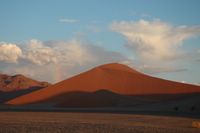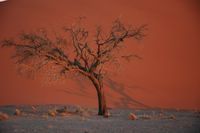Email Letter 4 (Complete Version)
March 30, 2005
Windhoek, Namibia
Dear All,
(This is a re-do since the original one got corrupted somehow)
Since it has been some time that we have written and much has happened both at work and “at play”, we have decided to write two separate E-letters: this one about work, and the other – E-letter 5, about our personal experiences and travel.
So, here we go:
We should tell you that we have been pretty busy at work doing a variety of things which of course keeps it more interesting.
We usually get up at 6, exercise while it is still cool, shower and eat, and head off to work about 7:45 or so and get to work at 8.00. If we are working in the office we stay until 5 or so.
In the office we have been helping to develop procedures and guidelines which the CAFO people have been using pertaining to proposal guidelines and proposal evaluations; fundraising and marketing techniques; strategic planning outlines; office and personnel policies and procedures; board training outlines; computer training; etc., etc., etc. So far, so good. As we did in Uganda last year, we will put all of this in a manual so that it will be easy to refer to when we leave. In a few days we are going to conduct a ½ day staff training about some of those things just mentioned so that we can answer questions, and do some hands on training.
We are never sure of how much of what we do will continue when we are gone, but our past experience tells us that some of it does, and we hope that it is more rather than less. In Uganda for example, it was quite a bit.
Here, we are beginning to see some of the things we have done being put to use and that is gratifying to us. Our goal is to build capacity rather than do it ourselves even though sometimes that is easier and faster. But it is now what we are about.
We have also just spent about 9 days on two different trainings: one in the far north of Namibia near the Angola border, and the other about 100 km south. In both of these trainings we have focused on helping grassroots groups organize around issues
The first training was in Rehoboth, some 90 km south of Windhoek. Rehoboth is where the Bastyrs live. Bastyrs are “coloreds” who migrated here from South Africa after suffering much discrimination. They are known for their toughness.
One of the problems in the Rehoboth community is youth violence and alcoholism. We were able to help the group there focus on how to begin to address the problem. Several of the group members were black women who normally “take a back seat” to the more educated non blacks in the group. Our facilitation helped them to become more vocal, and participate in the discussion which led to their suggestion to plan a meeting with the mayor and town council to discuss ways to address these problems. Just yesterday we learned that in fact this meeting with the Mayor will take place this coming Sunday. Everyone felt pretty good about the fact that a plan was created by different factions in the community working together, and will lead to some kind of positive action. This was also a good example of blacks and non blacks being able to work together to solve a common problem.
We also did some computer training in Rehoboth and one of the “learners” was a woman. She told Hinda that she had previously attended a 3 day computer workshop in Afrikaans and still could not master basic computer skills. As a result of Hinda’s teaching skills, this woman told us that even after ½ day of English training with Hinda she was able to learn. What’s Hinda’s technique? She taught her mouse dexterity by playing computer solitaire ! Hey Hinda, you’re supposed to be working, not playing!
We also spent about a week in the north on the border with Angola. Very different community and felt much more African than here in Windhoek which is pretty white. The north is where the Oshwambo people live, who comprise about 60% of Namibia’s population, and who speak Oshwambo.
Similar problems with OVC (Orphans and Vulnerable Children). We worked with a very small grassroots group which was meeting for the fist time together and helped them begin to prioritize the problems that they felt needed to be addressed. In this case it was to begin a campaign to educate the adults in the community about the problems of OVC. We met with them a second time and they got to the point of planning how to strategize. It was a small, but hopefully an important beginning and we hope they will continue on their own with some follow up support from CAFO.
One of the young women in the group told Hinda she was her “Kuku” – grandmother in the Oshwambo language. For those of you who want to call Hinda “kookoo”, it is now OK to do so!
These problems about OVC can be pretty bad. In Namibia, an orphan can have either one or no parents. A vulnerable child is one who is at risk of violence, abandonment, becoming orphaned, facing abuse, etc. Here there are a very large number of child headed households. Picture this: Your child, or grandchild of 8 or 9 being the head of a household and the sole provider to his or her younger siblings. Most of these kids don’t go to school. While the government can issue waivers for the cost of uniforms, and other cost items, they don’t do so willingly, and thus the bottom line is that poor children, whether OVC, Child Head of Household, or whatever, don’t get an education, and we all know where that will lead.
Never the less, we and others keep on working the problem, and even small victories are still victories.
Next week we are going back to Rehoboth with the PR guy from the US Embassy who we convinced to donate books to start small libraries in two elementary schools and a kids shelter. In one school there is a beautiful library room, but it is empty. Now it will have at least 100 books to begin with and the other school also 100 and the shelter will get 50. We are also hopeful of the US Embassy donating a re-furbished computer to CAFO. So that is some more good news.
We got to know this PR guy in an interesting way. When we were at a national conferece on OVC, he was trying to photograph the US Ambassador who was making a speech and his camera broke and he also didn’t have a press badge. Here comes Peter to the rescue with his press badge and camera that did work. So, one hand rubs the other – right?
That’s about it for now.
Hugs and kisses to all,
Peter and Hinda












